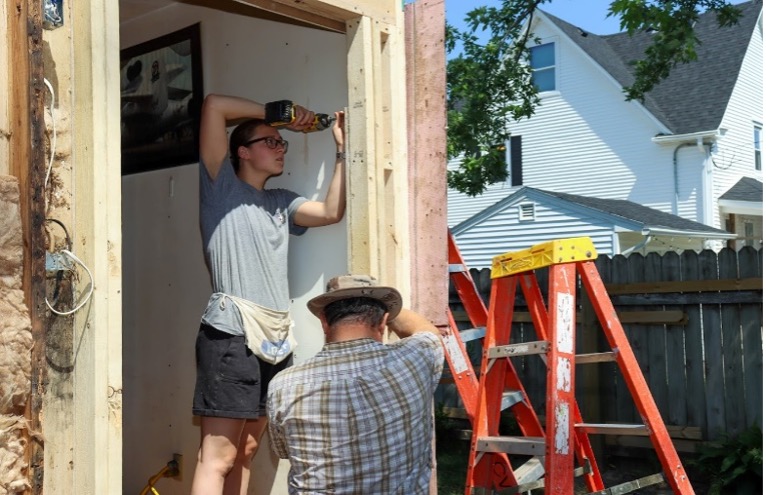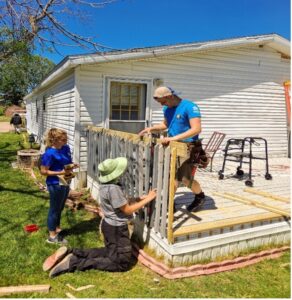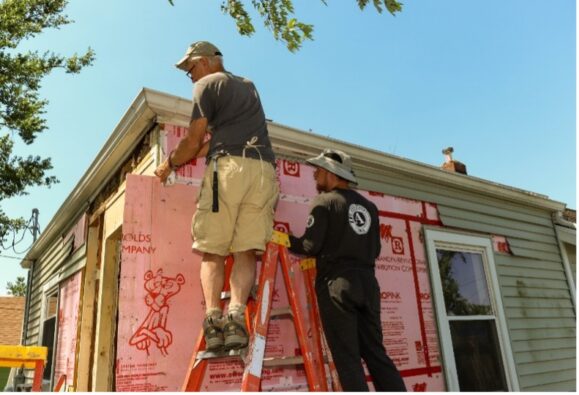Rebuilding after the Midwest derecho

Written by the staff at Habitat for Humanity Iowa.
The word “derecho” was unknown to most Iowans 12 months ago. That changed on Aug. 10, 2020.
Lisa Houser, the executive director for Habitat for Humanity of Iowa, was in her Altoona, Iowa, office preparing for a virtual meeting when suddenly the power, internet and phone lines went out. When she saw a large tree limb fly across her parking lot, she took shelter. Storms are nothing new in Iowa, but little did she know how different this one would be.
A derecho is a widespread, long-lived windstorm associated with a band of rapidly moving showers or thunderstorms. To be called a derecho, winds must exceed 58 mph at numerous locations along a corridor at least 250 miles long. The most significant derechos may produce wind gusts nearing 100 mph. The Midwest Derecho reached wind gusts of 140 mph. This is the same wind speed as a Category 4 hurricane. In some locations, wind gusts maintained speed for 30 to 45 minutes.
The Midwest Derecho is the costliest severe thunderstorm event in United States history, according to the National Weather Service. The storm touched eight states, with the most damage reported in Central and Eastern Iowa. Damaging winds covered at least 90,000 square miles, which is home to more than 20 million people. Significant damage included widespread power outages and downed trees, damage to homes and other structures, toppled semi-trailers and flattened crops over a large area.
“During the storm I was hiding with my dog, Lucy, in the bathroom. I could hear everything.”

Karlene has been living in her home since 1976, and she says she has never been through a worse storm. “At one point I thought it was over, and I peeked out the window. My 40-year-old elm tree was whipping around. That was a scary sight. I hope never to go through anything like that again.”
The derecho caused massive damage to her home, ripping the entire door frame away from the back door to her bedroom. The soffit and gutters were pulled down from the front, and that 40-year-old elm had crashed into her roof and front steps.
“I couldn’t even get out of my house. I could go as far as the front steps. The tree was down across them. I couldn’t get out the back door either because it was broken.”
In the immediate wake of the storm, her neighbors came and freed her from the home, but there was still so much to do. Karlene has slept for 10 months in a room with a partially destroyed corner. Her brother-in-law put up plastic to keep out the elements. With the help of Habitat for Humanity, she was able to rebuild the corner, replace the door and even take care of the soffit on the front of the home.
“You don’t know how much I appreciate it,” Karlene says. “I don’t know where I’d be today without their help. I’m so grateful.” As a way to say thank you, she intends to donate her late husband’s tools to the Habitat ReStore. “It’s the least I can do.”
Because of a generous $50,000 grant from the Center for Disaster Philanthropy (CDP), Habitat for Humanity of Iowa is able to help more disaster survivors like Karlene. The generous gift contributed to hiring a disaster construction manager to lead teams of volunteers and AmeriCorps members on disaster sites.
“For me, every project is a ‘feel-good moment,’ because every project is someone who needs help.”
C.J. is a member of the Habitat AmeriCorps Mobile Response Team. Since joining the team in September 2020, he’s worked on nearly 20 storm repair projects that resulted from the derecho. While some families recovered quickly, others have spent nearly a year with broken windows, missing roofs and few prospects for help.

C.J. continued, “It’s always good to help people, but when you help somebody who truly has nowhere else to turn, you can see how much it means to them. It’s important to remember that disaster survivors did nothing wrong. Storms affect everybody, but unfortunately, they disproportionately affect our lower-income neighborhoods.”
From mothers braving the winter in windowless rooms that never warmed up past 60 degrees to mobile homeowners losing half of their floor plan to trees and debris, Habitat has seen how the wounds of the derecho are still open for many Iowans.
“To survivors, it’s more than just money. To them, that’s a new home. That’s a new outlook on life. That’s a second chance at staying where they are and not having to move. It’s more than just a number on a piece of paper. It’s a means through which to improve somebody’s life.”
Over the past 12 months, Habitat for Humanity and their disaster mobile response team has supported more than 125 derecho families in Marshall, Tama, Benton and Linn Counties. But the work has not stopped. They will continue with derecho projects as long as needed. Habitat believes that everyone deserves opportunities to get their life back on track after a storm. And that starts with having a safe home.